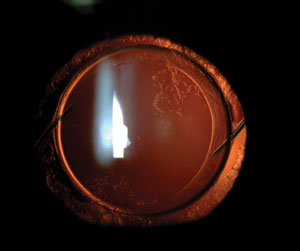 |
|
Though researchers hypothesized the opposite, they found that pseudophakic monovision doesn't increase fall risk in the elderly. Image courtesy of Gleb Sukhovolskiy, OD. Click image to enlarge. |
Several studies have investigated the impact of cataract surgery on fall risk, with some suggesting a reduction in risk, while others suggest an increase. However, none addressed post-op fall risk in the population of patients with pseudophakic monovision, in which one eye is set for near vision and the other for distance vision.
Using a large dataset, the researchers who conducted this recent study compared fall risk in older adults with pseudophakic monovision, pseudophakic single vision (bilateral cataract surgery with both eyes set for distance vision) and those with bilateral cataracts who had not undergone surgery. They concluded that although pseudophakic monovision did not impact fall risk, pseudophakic single-vision patients may actually face an increased risk of falls compared with those who haven’t yet had surgery.
A total of 13,385 patients were included in the study, of which 1.8% had pseudophakic monovision, 21% had pseudophakic single vision and 77.2% had not undergone surgery. When the researchers looked at the documented falls after cataract diagnosis, they found that pseudophakic single-vision patients had the highest fall rate of 7.9%, followed by no-surgery patients (5.9%) and pseudophakic monovision patients (5.8%). The overall rate of falls post-cataract diagnosis was 6.4%.
After being adjusted for age, sex and preexisting myopia, the data revealed no impact of pseudophakic monovision on fall risk in elderly patients. However, the pseudophakic single-vision group may face a disadvantage over the no-surgery group that explains the increased fall risk.
“The pseudophakic single-vision group had a significantly larger proportion of patients with a fall, a higher mean number of falls after cataract diagnosis and a faster time to fall compared with the no-surgery group,” the researchers wrote. “These findings suggest that perhaps the residual accommodation in cataract patients who have not undergone surgery may potentially protect against falls, because the ability to focus, although greatly diminished, is still retained in phakic cataract patients but not in pseudophakia.”
Patient age was also associated with fall risk, with older age at the time of cataract diagnosis and surgery shown to increase risk by 4.9% and 5.2%, respectively. Further research on the impact of cataract surgery on fall risk will help to better understand the relationship between the two and offer necessary preventative care and caution to populations at the highest risk.
Rosenblatt TR, Vail D, Ludwig CA, et al. Fall risk in patients with pseudophakic monovision. Can J Ophthalmol. August 19, 2021. [Epub ahead of print]. |

